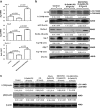Inhibition of glycogen synthase kinase 3β promotes autophagy to protect mice from acute liver failure mediated by peroxisome proliferator-activated receptor α
- PMID: 27010852
- PMCID: PMC4823957
- DOI: 10.1038/cddis.2016.56
Inhibition of glycogen synthase kinase 3β promotes autophagy to protect mice from acute liver failure mediated by peroxisome proliferator-activated receptor α
Abstract
Our previous studies have demonstrated that inhibition of glycogen synthase kinase 3β (GSK3β) activity protects mice from acute liver failure (ALF), whereas its protective and regulatory mechanism remains elusive. Autophagy is a recently recognized rudimentary cellular response to inflammation and injury. The aim of the present study was to test the hypothesis that inhibition of GSK3β mediates autophagy to inhibit liver inflammation and protect against ALF. In ALF mice model induced by D-galactosamine (D-GalN) and lipopolysaccharide (LPS), autophagy was repressed compared with normal control, and D-GalN/LPS can directly induce autophagic flux in the progression of ALF mice. Autophagy activation by rapamycin protected against liver injury and its inhibition by 3-methyladenine (3-MA) or autophagy gene 7 (Atg7) small interfering RNA (siRNA) exacerbated liver injury. The protective effect of GSK3β inhibition on ALF mice model depending on the induction of autophagy, because that inhibition of GSK3β promoted autophagy in vitro and in vivo, and inhibition of autophagy reversed liver protection and inflammation of GSK3β inhibition. Furthermore, inhibition of GSK3β increased the expression of peroxisome proliferator-activated receptor α (PPARα), and the downregulated PPARα by siRNA decreased autophagy induced by GSK3β inhibition. More importantly, the expressions of autophagy-related gene and PPARα are significantly downregulated and the activity of GSK3β is significantly upregulated in liver of ALF patients with hepatitis B virus. Thus, we have demonstrated the new pathological mechanism of ALF that the increased GSK3β activity suppresses autophagy to promote the occurrence and development of ALF by inhibiting PPARα pathway.
Figures







References
-
- Rolando N, Wade J, Davalos M, Wendon J, Philpott-Howard J, Williams R. The systemic inflammatory response syndrome in acute liver failure. Hepatology 2000; 32: 734–739. - PubMed
-
- Hoofnagle JH, Carithers RJ, Shapiro C, Ascher N. Fulminant hepatic failure: summary of a workshop. Hepatology 1995; 21: 240–252. - PubMed
-
- Cohen P, Goedert M. GSK3 inhibitors: development and therapeutic potential. Nat Rev Drug Discov 2004; 3: 479–487. - PubMed
Publication types
MeSH terms
Substances
LinkOut - more resources
Full Text Sources
Other Literature Sources

